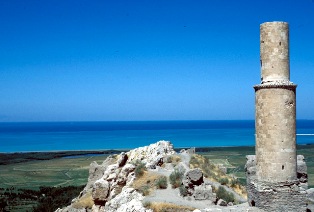An excerpt from the Safar-nama of Nasir Khusraw:
“From there (Harran) we arrived in the city of Akhlat on the 18th of Jumada al-Awwal [November 20 CE]. This city is the border town between the Muslims and Armenians, and from Bekri it is nineteen leagues. The Prince, Nasruddawla, was over a hundred years old and had many sons, to each of whom he had given a district. In the city of Akhlat they speak three languages: Arabic, Persian, and Armenian. It is my supposition that this is why they named the town Akhlat. Their commercial transactions are carried out in puls (possibly ancient Roman and Greek coins), and their rotel (Armenian money) is equivalent to three hundred dirhems.”
Source: Thackston, W. Wheeler McIntosh, ed. trans., Nasir-i Khusraw’s Book of Travels (Costa Mesa, CA: Mazda Publishers, 2010), 8.
Akhlat is a fortress town in Armenia at the North-Western corner of Lake Van, Turkey. The name Khlat is possibly connected with the ancient inhabitants of the country, the Urartian Khalds. The town lies half-way between the mountain massifs of Sipan Dagh and Nimrud Daggh on the route taken by invasions from Mesopotamia into eastern Armenia. The 9th CE century Persian historian, al-Baladhuri (d. 892 CE) writes that in the Arab view Erzerum, Ardish (Erciş) and either Apahunik, where Manazgird lies, or Bznunik (all towns in modern Lake Van district) were included in the district of Akhlat.
Akhlat during the Arab Rule: After the Arab conquest of Akhlat in 1 AH / 7th CE century, it was ruled by Arab governors, Armenian autonomous princes and the Arab Local Amir of the Kays tribe for four centuries. Towards 373 AH / 983 CE, Akhlat became part of the dominions of the Kurd Badh and was associated with the Marwanid princes untill the battle of Manazgird (463 AH / 1071 CE). After the battle of Kose Dagh in 641 AH / 1243 CE, the Mongols capured Akhlat. Three years later in 644 AH / 1246 CE, a severe earthquake largely destroyed the town.
Akhlat during the Ottman Rule: The Ottoman Sultan Selim I captured Akhlat in 955 AH / 1548 CE; however, he later lost it to Shah Tahmasp who levelled the city to the ground. Akhlat was then recaptured by the Ottoman Sultan Sulayman I and was finally incorporated into the Ottoman Empire. Sultan Sulayman built a citadel on the lake shore (probably completed in 962-963 AH / 1554-5 CE) and a small town arose in its vicinity.
During most of the Ottoman period, Akhlat remained under the rule of the local Kurdish chieftains. It was brought under the direct Ottoman administration by Mahmud II in 1847. At the end of the 19th century the population of Akhlat comprised of Muslims, Gregorian Armenians, Orthodox Greeks and Yazidis.
Archeology of Akhlat: The medieval town (Eski Akhlat) on the slope of the mountain is uninhabited and in ruins.The new town, with a large Ottoman inscription of Selim II 976 AH / 1568 CE on the main gate, lies to the East of it on the lake shore. The latter contains two mosques of the 16th century (Jami‘ Iskender Pasha with a minaret from 978 AH / 1570 CE, and Jami‘ Kadai Mahmud dating from 1006 AH / 1597 CE). Between the medieval and the modern towns is the famous cemetery, with richly ornamented tombstones, of the Seljuk, Mongol and Turkmen periods dating from 13th-16th century CE.
Citation:
“Akhlat.” Encyclopaedia of Islam, Second Edition. Brill Online, 2012. http://referenceworks.brillonline.com/entries/encyclopaedia-of-islam-2/akhlat-COM_0036 [accessed July 2013]
“Akhlat”. Encyclopaedia Iranica, Online. 2011.
http://www.iranicaonline.org/articles/aklat-or-greek-khliat-khleat-armenian-khlat-a-town-and-medieval-islamic-fortress-in-eastern-anatolia-in-the-former- [accessed July 2013]
Blaum, P., “A History of the Kurdish Marwanid Dynasty (983-1085), Part I”, Kurdish Studies: An International Journal, Vol. 5, No.1-2 (Spring/Fall 1992): 54–68.
Blaum, P. “A History of the Kurdish Marwanid Dynasty (983-1085), Part II”, Kurdish Studies: An International Journal, Vol. 6, No.1-2 (Fall 1993): 40–65.
Hunsberger, Alice C., Nasir Khusraw, the Ruby of Badakhshan (London, I. B. Tauris, 2000).
“Akhlat.” UNESCO Tentative list of World Heritage Sites
http://whc.unesco.org/en/tentativelists/1401/ [accessed July 2013]


